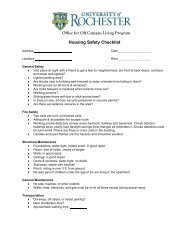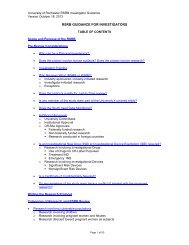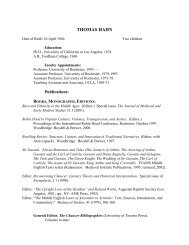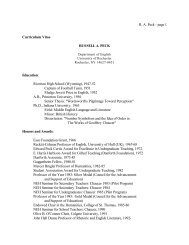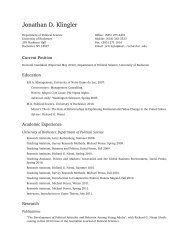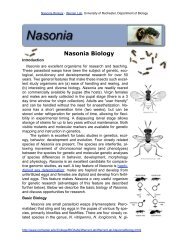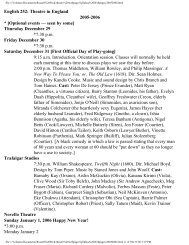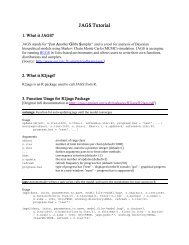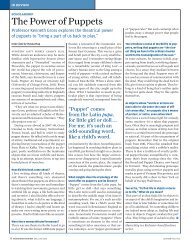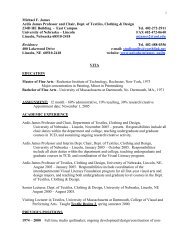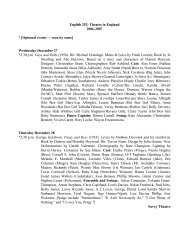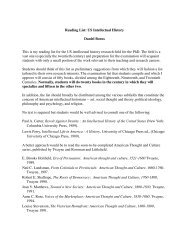Courses Offered at the College Music Department - University of ...
Courses Offered at the College Music Department - University of ...
Courses Offered at the College Music Department - University of ...
Create successful ePaper yourself
Turn your PDF publications into a flip-book with our unique Google optimized e-Paper software.
Course Descriptions<br />
Note: <strong>Courses</strong> are 4 credits unless noted o<strong>the</strong>rwise.<br />
<strong>University</strong> <strong>of</strong> Rochester<br />
COLLEGE MUSIC DEPARTMENT<br />
MUR 100 Experiencing <strong>Music</strong>.<br />
A new approach to "music appreci<strong>at</strong>ion" th<strong>at</strong> could be <strong>of</strong>fered only <strong>at</strong> <strong>the</strong> U <strong>of</strong> R, with its extraordinary musical resources, including nearly 800<br />
concerts and recitals per year, a pr<strong>of</strong>essional-quality recording studio, and <strong>the</strong> largest academic music library in <strong>the</strong> New World. This enjoyable<br />
course celebr<strong>at</strong>es <strong>the</strong> "ears-on" experience <strong>of</strong> various aspects <strong>of</strong> musical performance and assumes no previous technical training in music.<br />
Participants will develop listening skills through <strong>the</strong> enjoyment <strong>of</strong> live musical present<strong>at</strong>ions, in-class performances, discussions with <strong>the</strong><br />
performers and living composers and guided listening sessions. Students will <strong>at</strong>tend some rehearsals and concerts, including <strong>at</strong> least one<br />
Rochester Philharmonic concert <strong>at</strong> <strong>the</strong> Eastman The<strong>at</strong>re. Web sites and o<strong>the</strong>r technological media will also be used in lieu <strong>of</strong> text. (Altern<strong>at</strong>e<br />
Spring Semesters)<br />
MUR 101 Elements <strong>of</strong> <strong>Music</strong>.<br />
A course for <strong>the</strong> student with no previous musical experience. Topics covered include not<strong>at</strong>ion, intervals, chords, and o<strong>the</strong>r basic concepts <strong>of</strong><br />
tonal harmony, with applic<strong>at</strong>ion to <strong>the</strong> study <strong>of</strong> a wide range <strong>of</strong> styles including popular idioms. Students should not be able to read music.<br />
Prerequisite for MUR 111. (Fall and Spring)<br />
MUR 103 <strong>Music</strong>al Adventures: Too Hip a Trip to Miss.<br />
Bach to Coolio--and lots <strong>of</strong> stops in between--this course will explore <strong>the</strong> wonderful world <strong>of</strong> music. We'll fill our backpack with a few<br />
essentials for our journey: some musical vocabulary and grammar. We'll explore questions such as, "Wh<strong>at</strong> is music?" and "Why humans make<br />
it?" We'll find out wh<strong>at</strong> one ano<strong>the</strong>r <strong>of</strong> us think is musically "mint" and musically "gross" and why. We'll explore <strong>the</strong> interesting world <strong>of</strong><br />
musical sounds and style Chicago, and Harlem. From concert halls to church halls; from beer halls to dance halls, we'll go in search <strong>of</strong> music.<br />
We'll meet Dukes and Counts and Princes and Queens, royal and o<strong>the</strong>rwise. And because everyone has some spirit <strong>of</strong> invention, we may even<br />
try our hand <strong>at</strong> a little musical cre<strong>at</strong>ion. No prerequisites. (Spring only)<br />
MUR 104 Carillon.<br />
Priv<strong>at</strong>e carillon instruction, weekly 30-minute lessons or <strong>the</strong> equivalent. By audition only. Permission <strong>of</strong> instructor required. (2 credits)<br />
MUR 106 A Brief History <strong>of</strong> Western <strong>Music</strong>.<br />
This course is meant to be both a traditional class in music appreci<strong>at</strong>ion and a broad survey <strong>of</strong> Western not<strong>at</strong>ed music from its earliest<br />
manifest<strong>at</strong>ions up to <strong>the</strong> present day. Early lectures and assignments will help students develop more sophistic<strong>at</strong>ed listening skills and a<br />
conceptual vocabulary with which to talk about music. We will <strong>the</strong>n focus on represent<strong>at</strong>ive pieces from each major art-historical period<br />
(Medieval, Renaissance, Baroque, Classical, Romantic, Modern, Postmodern) as well as explore how th<strong>at</strong> music functioned and held meaning for<br />
<strong>the</strong> people th<strong>at</strong> composed and listened to it. Exams will test knowledge <strong>of</strong> repertory and musical style, and short writing assignments will venture<br />
into more detailed analyses and interpret<strong>at</strong>ions <strong>of</strong> musical works.<br />
MUR 109 <strong>Music</strong>ianship I: Literacy Skills.<br />
This course introduces students to basic musicianship skills. The course begins with exercises in pitch m<strong>at</strong>ching and basic interval recognition<br />
and progresses toward o<strong>the</strong>r skills, such as singing simple melodies <strong>at</strong> sight, sight-reading various rhythmic p<strong>at</strong>terns, and dict<strong>at</strong>ing simple<br />
melodies and chord progressions. We recommend th<strong>at</strong> prospective music majors, especially those with prior singing experience, skip this course<br />
and begin with MUR 113. (Fall and Spring) (1 credit)<br />
MUR 110 Introduction to <strong>Music</strong> Theory.<br />
Basic concepts <strong>of</strong> music <strong>the</strong>ory, addressing students with some musical experience in an instrument or voice, but little or no music <strong>the</strong>ory.<br />
Scales, keys, intervals, chords, basic part-writing, and o<strong>the</strong>r fundamental aspects <strong>of</strong> musical structure. Some ear training and aural skills.<br />
Prerequisite: The ability to read music, preferably in both treble and bass clefs. Students who have completed MUR 101 should NOT register<br />
for MUR 110. (Fall )<br />
MUR 111 Theory I.<br />
The first in a four-course sequence. Deals with basic elements <strong>of</strong> harmony, voice-leading, and analysis. Part-writing in chorale style teaches<br />
elementary aspects <strong>of</strong> tonal <strong>the</strong>ory. Prospective music majors should begin <strong>the</strong>ir <strong>the</strong>ory requirement with this course. Prerequisites: MUR 101,<br />
110 or permission <strong>of</strong> instructor (placement test). (Fall only)<br />
MUR 112 Theory II.<br />
Continu<strong>at</strong>ion <strong>of</strong> MUR 111. This course continues with chorale and keyboard-style harmony exercises, but also introduces chrom<strong>at</strong>icism,<br />
modul<strong>at</strong>ion, and analysis <strong>of</strong> form and phrase structure. Prerequisite: MUR 111. (Spring only)<br />
MUR 113 <strong>Music</strong>ianship II.<br />
This course develops basic musicianship skills with an emphasis <strong>of</strong> di<strong>at</strong>onic sight-singing, rhythmic sight-reading, and dict<strong>at</strong>ion <strong>of</strong> di<strong>at</strong>onic<br />
melodies and chord progressions. The exercises and in-class activities are similar to MUR 109 but <strong>at</strong> a more advanced level. (Fall and Spring)<br />
(1 credit)
MUR 114 <strong>Music</strong>ianship III.<br />
Continu<strong>at</strong>ion <strong>of</strong> MUR 113 with an increased emphasis on chrom- <strong>at</strong>icism, especially simple modul<strong>at</strong>ion and mode mixture. The course puts<br />
emphasis on ensemble singing and aural analysis. Prerequisites: MUR 113 or permission <strong>of</strong> <strong>the</strong>ory coordin<strong>at</strong>or. (Fall and Spring) (1 credit)<br />
MUR 115 <strong>Music</strong>ianship IV.<br />
Continu<strong>at</strong>ion <strong>of</strong> MUR 114 with gre<strong>at</strong>er emphasis on chrom<strong>at</strong>icism and aural analysis. Prerequisite: MUR 114. (Fall and Spring) (1credit)<br />
MUR 116 Keyboard Skills I.<br />
Introduces students to <strong>the</strong> keyboard as a vehicle for broader musical development. Covers basic piano technique, sight-reading <strong>of</strong> simple chord<br />
progressions, realiz<strong>at</strong>ion <strong>of</strong> figured bass, and basic improvis<strong>at</strong>ion. No prior keyboard training required. Permission <strong>of</strong> instructor required. (Fall<br />
and Spring) (2 credits)<br />
MUR 117 Keyboard Skills II.<br />
Continu<strong>at</strong>ion <strong>of</strong> MUR 116. Students completing this course fulfill <strong>the</strong> piano pr<strong>of</strong>iciency for <strong>the</strong> music major. Prerequisite: MUR 116 or<br />
permission <strong>of</strong> instructor. (Fall and Spring) (2 credits)<br />
MUR 118 Beginning Piano for Non-<strong>Music</strong> Majors I.<br />
Elective course for non-music majors from River Campus with no previous keyboard instruction and cannot read music. The course will include<br />
technique, fundamental skills, and repertoire. *note: limited se<strong>at</strong>ing due to keyboard availability, no additional students taken once <strong>the</strong> sessions<br />
are full. Classes on ESM campus. See ESM website for info on start d<strong>at</strong>e, cancell<strong>at</strong>ions, etc; http://www.esm.rochester.edu/classpiano/<br />
(Fall only) (2 credits)<br />
MUR 119 Beginning Piano for Non-<strong>Music</strong> Majors II.<br />
Continu<strong>at</strong>ion <strong>of</strong> MUR 118. *see note above (Spring) (2 credits)<br />
MUR 120 Symphony and <strong>the</strong> Conductor.<br />
Offering <strong>the</strong> student glimpses into <strong>the</strong> world <strong>of</strong> standard orchestral performance as well as an overview <strong>of</strong> <strong>the</strong> métier <strong>of</strong> <strong>the</strong> orchestra<br />
conductor. In addition to <strong>the</strong> ability to read music, knowledge <strong>of</strong> basic music <strong>the</strong>ory, participants must have a love for and active interest in<br />
symphonic music and <strong>the</strong> process <strong>of</strong> its prepar<strong>at</strong>ion and performance. In addition to class lectures, students will visit orchestral rehearsals <strong>of</strong>f-and<br />
on-campus, view rehearsal and performance videos, enjoy interactions with local conductors, arts managers, orchestral musicians, and also <strong>at</strong>tend<br />
orchestra concerts. Prerequisite: MUR 111 or Permission <strong>of</strong> Instructor (Altern<strong>at</strong>e Spring Semesters only)<br />
MUR 121 World <strong>Music</strong>s.<br />
Engaging an extraordinary diversity <strong>of</strong> sound, this course explores some <strong>of</strong> <strong>the</strong> world's major traditions <strong>of</strong> musical performance, including<br />
classical, ritual, and ceremonial music from around <strong>the</strong> globe. Through weekly reading and listening assignments, we will study musical sound<br />
structures within a variety <strong>of</strong> social, political, and religious contexts, investig<strong>at</strong>ing rel<strong>at</strong>ionships between music, people, and place. In addition to<br />
well-known modes <strong>of</strong> music making, we will look <strong>at</strong> many fascin<strong>at</strong>ing but less familiar forms <strong>of</strong> musical expression, such as aboriginal pop<br />
music from Australia, <strong>the</strong> thro<strong>at</strong>-singing traditions <strong>of</strong> Tuva and Mongolia, and <strong>the</strong> freedom songs <strong>of</strong> South Africa. The course will culmin<strong>at</strong>e in a<br />
semester-long final project. No prerequisites.<br />
MUR 122A History <strong>of</strong> Jazz I.<br />
This study <strong>of</strong> Jazz, as an American musical art form, will be structured around <strong>the</strong> lives and music <strong>of</strong> jazz musicians, across a range <strong>of</strong><br />
instrumental, vocal, and ensemble genres. Course focuses on jazz titans, those individuals and musical groups distinguished by <strong>the</strong>ir seminal and<br />
permanent influences, such as Louis Armstrong, Miles Davis, or Coleman Hawkins or shorter intense careers, such as Charlie Parker. Blues,<br />
ragtime, swing, bebop, cool, progressive, and free jazz are landmark terms. And finally, study <strong>of</strong> <strong>the</strong> musical history will be enhanced by<br />
consider<strong>at</strong>ions from sociological, linguistic, and philosophical perspectives. The instructional form<strong>at</strong> includes lectures, discussion and intense<br />
emphasis on listening. This course is designed for students with little or no musical training; simple technical, musical vocabulary and concepts<br />
will be provided. Reading, listening assignments, brief written assignments and two exams. No prerequisites. (Fall Only)<br />
MUR 122B History <strong>of</strong> Jazz II.<br />
This course will focus on Jazz music and musicians in <strong>the</strong> l<strong>at</strong>ter half <strong>of</strong> <strong>the</strong> 20th century (ca. 1955-2000). We will investig<strong>at</strong>e <strong>the</strong> rel<strong>at</strong>ionship <strong>of</strong><br />
Jazz to <strong>the</strong> following topics: new musical styles, o<strong>the</strong>r art forms, changes in American society, technological developments, and <strong>the</strong> evolution <strong>of</strong><br />
recording, broadcast, and news media. In doing so, we will consider not only musicians who first emerged as leaders during this period (Ornette<br />
Coleman, John Coltrane, Bill Evans, Herbie Hancock, Keith Jarrett, Chick Corea, Wynton Marsalis, John Sc<strong>of</strong>ield), but also those whose careers<br />
began earlier (Louis Armstrong, Dizzy Gillespie, Miles Davis, Gil Evans) and continued into <strong>the</strong> 1950s and beyond. We will also examine how<br />
repertoire from previous historical periods came to be viewed by subsequent gener<strong>at</strong>ions <strong>of</strong> musicians and listeners. The instructional form<strong>at</strong><br />
includes lectures and discussion along with in-class viewings/listenings <strong>of</strong> recorded performances. This course is designed for students with little<br />
or no musical training. The coursework will consist <strong>of</strong> assigned readings, listenings, brief written assignments and two exams. There are no<br />
prerequisites.<br />
MUR 123 <strong>Music</strong> <strong>of</strong> Black Americans.<br />
The course will study <strong>the</strong> Black American Christian musical beginnings and includes forms <strong>of</strong> worship, early musical practices, <strong>the</strong> Spiritual,<br />
evolution <strong>of</strong> Gospel. An examin<strong>at</strong>ion <strong>of</strong> ante-bellum musical activities follows including secular song types, character <strong>of</strong> <strong>the</strong> folk music with<br />
respect to poetic and musical form, language and <strong>the</strong>mes. Attention will be given to significant literary and aes<strong>the</strong>tic developments, especially<br />
during <strong>the</strong> Harlem Renaissance and <strong>the</strong> poetry <strong>of</strong> several writers <strong>of</strong> th<strong>at</strong> era will be surveyed. The course will tre<strong>at</strong> Blues, its origins evolution<br />
through <strong>the</strong> 1940s. Surveys <strong>of</strong> classical music forms from <strong>the</strong> 18th to mid-20th century; music <strong>of</strong> <strong>the</strong> <strong>the</strong><strong>at</strong>er from minstrelsy to Broadway;<br />
precursors <strong>of</strong> jazz, <strong>the</strong> syncop<strong>at</strong>ed dance orchestra and brass bands; early jazz to bebop round out <strong>the</strong> course <strong>of</strong>ferings. (Spring only)
MUR 124 Signed Sealed & Delivered: Deals & Innov<strong>at</strong>ions th<strong>at</strong> Changed <strong>the</strong> <strong>Music</strong> Industry Forever.<br />
A look <strong>at</strong> <strong>the</strong> historical deals and innov<strong>at</strong>ions th<strong>at</strong> have impacted <strong>the</strong> music business between 1877 to present. From ground breaking inventions<br />
to brilliant marketing initi<strong>at</strong>ives to hushed back-room deals, this course will expose <strong>the</strong> key moments where <strong>the</strong> record industry changed forever,<br />
both for good and bad. (2 credits)<br />
MUR 125 History <strong>of</strong> Rock <strong>Music</strong>.<br />
This course will explore <strong>the</strong> history <strong>of</strong> rock music, emphasizing primarily <strong>the</strong> period between 1955 and 1990. The periods preceding (1900-<br />
1955) and following (1990-present) will also be considered to a limited extent. Discussion and reading will focus mostly on <strong>the</strong> music,<br />
identifying a wide variety <strong>of</strong> rock-music styles within <strong>the</strong> historical context <strong>of</strong> <strong>the</strong> development, transform<strong>at</strong>ion, and interaction <strong>of</strong> pop styles <strong>of</strong><br />
<strong>the</strong>se decades in general. Issues <strong>of</strong> technological development, social, political, and cultural context, race and gender, and music-business<br />
practices will also be considered. No prerequisites: Knowledge <strong>of</strong> technical musical terms and ability to read music are NOT required for this<br />
course.<br />
MUR 126 Opera.<br />
A small number <strong>of</strong> represent<strong>at</strong>ive operas will be used to highlight <strong>the</strong> history <strong>of</strong> this controversial 400-year old art form and its cre<strong>at</strong>ors,<br />
performers, and audiences. Drama, music, staging, spectacle, and dance will be examined as components <strong>of</strong> production. Divas welcome.<br />
Prerequisite: ability to read music.<br />
MUR 127 The Blues.<br />
See online course description for REL 151.<br />
MUR 128 Women and <strong>Music</strong>.<br />
This course will focus primarily on women composers but will also include m<strong>at</strong>erial on women as performers, p<strong>at</strong>rons, and consumers, as well as<br />
consider<strong>at</strong>ion <strong>of</strong> <strong>the</strong> role th<strong>at</strong> gender plays in <strong>the</strong> experience <strong>of</strong> music. No prerequisite.<br />
MUR 130 The Be<strong>at</strong>les, <strong>the</strong> British Invasion, and Psychedelia.<br />
The history <strong>of</strong> <strong>the</strong> Be<strong>at</strong>les career and music is explored in <strong>the</strong> context <strong>of</strong> <strong>the</strong> band’s stylistic development, as well as against <strong>the</strong> backdrop <strong>of</strong><br />
social, cultural, technical, and music-business events and issues <strong>of</strong> <strong>the</strong> 1950s, 60s and 70s. No background in music <strong>the</strong>ory or ability to play a<br />
musical instrument is required.<br />
MUR 131 Rock <strong>Music</strong> in <strong>the</strong> 1970’s.<br />
This course will survey rock music in <strong>the</strong> 1970s, paying special <strong>at</strong>tention to ways in which 70s styles developed out <strong>of</strong> 60s styles. Artists<br />
considered will include Jimi Hendrix, Cream, Yes, Led Zeppelin, The Who, The Allman Bro<strong>the</strong>rs, The Eagles, Black Sabb<strong>at</strong>h, The Cars, Tom<br />
Petty, The Sex Pistols and Elvis Costello, plus many more. No previous musical training required.<br />
MUR 132 StarMakers: Inside <strong>the</strong> Publicity Machine.<br />
Will include a historical overview <strong>of</strong> music stars and <strong>the</strong> publicity campaigns used to promote <strong>the</strong>ir careers.<br />
From Frank Sin<strong>at</strong>ra-1940s; through Elvis Presley;-1950s; through The Be<strong>at</strong>les & The Rolling Stones in <strong>the</strong> 1960s, up through self-indulgent 70s<br />
with acts like Elton John, Kiss, and Prince, up to today's high pr<strong>of</strong>ile campaigns for Justin Bieber, Rhianna and Lady Gaga. Students will be<br />
versed in <strong>the</strong> art <strong>of</strong> writing an artist bio, press releases, and in <strong>the</strong> various types <strong>of</strong> Public Rel<strong>at</strong>ions events staged to gain publicity, Starmakers<br />
will also look <strong>at</strong> <strong>the</strong> various types <strong>of</strong> publicity such as career launching; crisis management(scandals; sudden de<strong>at</strong>h <strong>of</strong> celebrity) and tour press.<br />
We will also look <strong>at</strong> how social media has become a game changer for music publicity. (2 credits)<br />
MUR 133 <strong>Music</strong>al The<strong>at</strong>er Workshop.<br />
Intensive practical experience with scene-and-song work in <strong>the</strong> repertory <strong>of</strong> popular musical <strong>the</strong><strong>at</strong>er genres. Weekly rehearsals and critique<br />
sessions, with emphasis on characteriz<strong>at</strong>ion, technical skills, sub-textual dimensions, and stylistic consider<strong>at</strong>ions. Some reading assignments, but<br />
emphasis is on <strong>the</strong> prepar<strong>at</strong>ion for performance. Initial and concluding videotaping <strong>of</strong> "audition piece." Prerequisite: One year <strong>of</strong> voice<br />
instruction; permission <strong>of</strong> instructor (by audition). (Spring only)<br />
MUR 134 Styles & Genres: Introduction to <strong>Music</strong> History.<br />
An introduction to <strong>the</strong> history <strong>of</strong> Western classical music from <strong>the</strong> Middle Ages to <strong>the</strong> present, with emphasis on recognition <strong>of</strong> <strong>the</strong> chief stylistic<br />
characteristics and understanding <strong>of</strong> major genres <strong>of</strong> each period. Prerequisite: MUR 112 or permission <strong>of</strong> instructor.<br />
(Fall or Spring semester)<br />
MUR 135A American <strong>Music</strong>al The<strong>at</strong>er<br />
A historical and critical survey <strong>of</strong> <strong>the</strong> Broadway musical, with a focus on its so-called Golden Age (from Oklahoma! to Cabaret). Weekly<br />
listening, reading, and video assignments with analysis <strong>of</strong> dram<strong>at</strong>urgy, lyric and musical forms, process <strong>of</strong> adapt<strong>at</strong>ion and production, modes <strong>of</strong><br />
performance. Prerequisite: ability to read music or strong background/interest in musical <strong>the</strong><strong>at</strong>er. (Altern<strong>at</strong>e Spring semesters)<br />
MUR 135B Sondheim and <strong>the</strong> Modern <strong>Music</strong>al The<strong>at</strong>er<br />
A historical and critical survey <strong>of</strong> <strong>the</strong> American musical <strong>the</strong><strong>at</strong>er from roughly 1960 to <strong>the</strong> present, as reflected principally in <strong>the</strong> works <strong>of</strong><br />
composer/lyricist Stephen Sondheim and/or producer/director Harold Prince. Analysis <strong>of</strong> lyrics, musical forms and idioms, process <strong>of</strong> adapt<strong>at</strong>ion<br />
and production, modes <strong>of</strong> performance. Although prior completion <strong>of</strong> MUR 135A is recommended, students with a strong background in<br />
musical <strong>the</strong><strong>at</strong>er will be admitted as well. (Fall, altern<strong>at</strong>e years)<br />
MUR 136 Shakespeare and <strong>Music</strong><br />
<strong>Music</strong> is inextricably woven into <strong>the</strong> plays <strong>of</strong> Shakespeare, and those plays have inspired composers for hundreds <strong>of</strong> years. The course<br />
investig<strong>at</strong>es <strong>the</strong> musical world <strong>of</strong> Shakespeare's day, <strong>the</strong> specific uses <strong>of</strong> music within his plays, <strong>the</strong>ir revivals, and <strong>the</strong> musical represent<strong>at</strong>ion <strong>of</strong><br />
Shakespearean <strong>the</strong>mes by l<strong>at</strong>er composers, including Mendelssohn, Tchaikovsky, Verdi and Britten. No prerequisites.
MUR 137 Thinking About <strong>Music</strong><br />
Everyone knows th<strong>at</strong> music can elicit a wide variety <strong>of</strong> emotions. But whe<strong>the</strong>r classical or jazz, punk, rock, or gospel, music also communic<strong>at</strong>es<br />
countless o<strong>the</strong>r meanings, denoting aspects <strong>of</strong> race, religion, gender, culture, and politics. This course will explore various ways <strong>of</strong> thinking<br />
about musical meaning. After first building a musical vocabulary, we will discuss many kinds <strong>of</strong> music in different contexts, including classical<br />
and popular music, Broadway and opera, film scores, music videos, advertisements, and religious and nonwestern traditions.<br />
MUR 138 Introduction to Conducting<br />
This course is designed for students with little to no experience leading a musical ensemble. After mastering <strong>the</strong> basics <strong>of</strong> b<strong>at</strong>on technique, be<strong>at</strong><br />
p<strong>at</strong>terns, prepar<strong>at</strong>ions/releases, and cueing, students will gain hands-on experience leading a small ensemble comprised <strong>of</strong> fellow classm<strong>at</strong>es<br />
playing instruments or singing. This course also addresses <strong>the</strong> joys and pitfalls <strong>of</strong> conducting choirs, jazz/popular music ensembles, pit<br />
orchestras, and a cappella groups. Each student will be given <strong>the</strong> opportunity to conduct a large instrumental ensemble as a “final exam.”<br />
Assignments will include short readings and research on various aspects <strong>of</strong> conducting, with <strong>the</strong> bulk <strong>of</strong> <strong>the</strong> course work taking place in class.<br />
Prerequisites: Ability to read music and pr<strong>of</strong>iciency on an instrument or voice (for particip<strong>at</strong>ion in <strong>the</strong> small in-class ensemble). (2 credits)<br />
MUR 139 Judaism and its <strong>Music</strong><br />
See online course description for REL 217<br />
MUR 140 Religion and Hip Hop Culture<br />
See online course description for REL 170<br />
MUR 141 Introduction to Audio and <strong>Music</strong> Engineering.<br />
See online course description for AME 140<br />
MUR 145 High Voltage: Heavy Metal <strong>Music</strong> and its History.<br />
Behind <strong>the</strong> screaming guitars, thundering pulse, and soaring vocals <strong>of</strong> heavy metal music lies an impressive history <strong>of</strong> censorship, rebellion, and<br />
redemption. In this course, students will study both <strong>the</strong> musical structure and <strong>the</strong> fascin<strong>at</strong>ing social/cultural history <strong>of</strong> hard rock and metal<br />
through reading, listening, discussion, and analysis. Over 40 years <strong>of</strong> hard rock and metal trends will be discussed-- Sabb<strong>at</strong>h to Stryper to<br />
Slipknot-- and several guest musicians and lecturers will complement <strong>the</strong> course m<strong>at</strong>erials with performances and anecdotes. Students will<br />
demonstr<strong>at</strong>e <strong>the</strong>ir knowledge through listening quizzes, three full-length exams, writing assignments, and a comprehensive final project. No<br />
prerequisites.<br />
MUR 161 Broadcasting in <strong>the</strong> Digital Age.<br />
A descriptive and critical analysis <strong>of</strong> <strong>the</strong> n<strong>at</strong>ure <strong>of</strong> electronic mass media, broadcast practices and impact. Historical development <strong>of</strong> mass media<br />
institutions and role <strong>of</strong> media in society, including evalu<strong>at</strong>ion <strong>of</strong> news, government regul<strong>at</strong>ion, economics, emerging technologies, and audience<br />
dynamics, as well as decision-making and organiz<strong>at</strong>ional aspects <strong>of</strong> <strong>the</strong> broadcast industry. Designed to provide a broad, rigorous orient<strong>at</strong>ion for<br />
understanding basic elements <strong>of</strong> media production as well as skills training in reporting, writing, editing, delivery and production <strong>of</strong> broadcast<br />
media. (Spring only)<br />
MUR 162 <strong>Music</strong> and <strong>the</strong> Mind.<br />
See online course description for 6TH 260. (Spring only)<br />
MUR 181 GTR Class: Beyond <strong>the</strong> Basics.<br />
This is an introductory guitar class th<strong>at</strong> will teach guitar fundamentals and get students playing popular, rock, blues, classical, and simple jazz<br />
tunes by <strong>the</strong> end <strong>of</strong> <strong>the</strong> semester. This course is open to all guitar enthusiasts as well as music majors/minors seeking a 'methods class' approach<br />
to learning <strong>the</strong> instrument. Electric and acoustic guitars welcome. Contact Pr<strong>of</strong> Bob Sneider bsneider@esm.rochester.edu with any questions.<br />
(2 credits)<br />
MUR 183 GTR Class: Intro to Classical Guitar.<br />
Intro to Classical Guitar will introduce students to rudiments <strong>of</strong> classical guitar technique, including tuning, basic posture and position, chord<br />
form<strong>at</strong>ion, note reading, and introduction to repertoire. Basic ensemble techniques will be incorpor<strong>at</strong>ed into class sessions. (2 credits)<br />
MUR 191 Art and Technology <strong>of</strong> Recording.<br />
See online course description for AME 191<br />
MUR 192 Listening and Audio Production.<br />
See online course description for AME 192<br />
MUR 193 Computer Sound Design.<br />
See online course description for AME 193.<br />
MUR 201 Basic Jazz Theory & Improv I.<br />
Rudiments <strong>of</strong> jazz, including chord and scale spellings, chord scale rel<strong>at</strong>ionships, jazz/pop chord symbol nomencl<strong>at</strong>ure, basic forms, chord<br />
substitutions, piano voicing; strong emphasis on ear training and vocaliz<strong>at</strong>ion and transcription from records <strong>of</strong> jazz solos. Prerequisite: MUR<br />
111 or permission <strong>of</strong> <strong>the</strong> instructor. (Fall only) (4 credits)<br />
MUR 202 Basic Jazz Theory & Improv II.<br />
Continu<strong>at</strong>ion <strong>of</strong> MUR 201. Prerequisite: MUR 201 or permission <strong>of</strong> <strong>the</strong> instructor. (Spring only) (4 credits)<br />
MUR 203 Susan B. Anthony and Her World.<br />
See online course description for WST 201
MUR 204 Carillon.<br />
Priv<strong>at</strong>e carillon instruction, weekly 60-minute lessons. By audition only. Permission <strong>of</strong> instructor required. (4 credits)<br />
MUR 211 Theory III.<br />
Continu<strong>at</strong>ion <strong>of</strong> MUR 112. Focuses on analysis <strong>of</strong> large forms, such as son<strong>at</strong>a, rondo, and song forms. Includes advanced study <strong>of</strong> chrom<strong>at</strong>ic<br />
harmony and modul<strong>at</strong>ion to remote keys. Prerequisite: MUR 112. (Fall only)<br />
MUR 212 Theory IV.<br />
Continu<strong>at</strong>ion <strong>of</strong> MUR 211. Explores <strong>the</strong> <strong>the</strong>oretical and aes<strong>the</strong>tic principles <strong>of</strong> twentieth-century music, especially in rel<strong>at</strong>ion to earlier<br />
compositional procedures. Introduces basic post-tonal <strong>the</strong>ory, including set-class analysis, transform<strong>at</strong>ional <strong>the</strong>ory, and serial techniques.<br />
Prerequisite: MUR 211. (Spring only)<br />
MUR 214B Topics in <strong>Music</strong> Theory: Analysis <strong>of</strong> Popular <strong>Music</strong>.<br />
Many people love pop music for its simplicity, but this course will reveal th<strong>at</strong> pop music can <strong>of</strong>ten be surprisingly complex in <strong>the</strong> ways it projects<br />
structure and cre<strong>at</strong>es musical rel<strong>at</strong>ionships. Many dimensions <strong>of</strong> pop music will be analyzed, including harmony, melody, rhythm and meter,<br />
texture, form, recording technique, and text-music rel<strong>at</strong>ionships. Prerequisites: MUR 112.<br />
MUR 221 History <strong>of</strong> Western <strong>Music</strong> to 1600.<br />
Survey <strong>of</strong> Western classical music through 1600, including <strong>the</strong> investig<strong>at</strong>ion <strong>of</strong> style, genre, transmission, contemporary <strong>the</strong>ory, p<strong>at</strong>ronage,<br />
cultural context and meaning, etc. Workshops deal with topics such as transcription and performance practice.<br />
Prerequisite: Completion <strong>of</strong> or current enrollment in MUR 111. For sophomores and above. (Fall) (5 credits)<br />
MUR 222 History <strong>of</strong> Western <strong>Music</strong> ca. 1600 through 1750.<br />
Survey <strong>of</strong> Western classical music from ca. 1600 to <strong>the</strong> mid-eighteenth century, with emphasis on <strong>the</strong> stylistic, generic, and performance<br />
innov<strong>at</strong>ions <strong>of</strong> <strong>the</strong> period; opera receives special <strong>at</strong>tention. Workshops investig<strong>at</strong>e specific problems posed by not<strong>at</strong>ion, performance, ethics, and<br />
so on. Prerequisite: MUR 221, completion or current enrollment in MUR 112. (Spring) (5 credits)<br />
MUR 223 History <strong>of</strong> Western <strong>Music</strong> 1750-1850.<br />
The history <strong>of</strong> western art music from approxim<strong>at</strong>ely 1730-1850, with an emphasis on analysis <strong>of</strong> <strong>the</strong> masterpieces <strong>of</strong> tonal music and <strong>the</strong>ir<br />
rel<strong>at</strong>ionship to society and o<strong>the</strong>r arts. Lectures with extensive listening, reading, and analysis.<br />
Prerequisite: MUR 222, MUR 212. (Fall) (5 credits)<br />
MUR 224 History <strong>of</strong> Western <strong>Music</strong>: 1850-Present.<br />
The history <strong>of</strong> western art music from approxim<strong>at</strong>ely 1850 through <strong>the</strong> present, with an emphasis on <strong>the</strong> changing meaning <strong>of</strong> "New <strong>Music</strong>"<br />
and its role in society. Analysis <strong>of</strong> post-Wagnerian tonal music and non-tonal altern<strong>at</strong>ives. Lectures, with extensive listening and reading, as<br />
well as analytical assignments. Prerequisite: MUR 223, MUR 212. (Spring) (5 credits)<br />
MUR 233 Advanced <strong>Music</strong>al The<strong>at</strong>er Workshop.<br />
Continu<strong>at</strong>ion <strong>of</strong> MUR 133. Prerequisite: MUR 133 and permission <strong>of</strong> <strong>the</strong> instructor. (Spring only)<br />
MUR 234/434 <strong>Music</strong> Analysis: The Be<strong>at</strong>les<br />
This course is designed for upper-level undergradu<strong>at</strong>e music majors and gradu<strong>at</strong>e students in music. We will analyze <strong>the</strong> music <strong>of</strong> <strong>the</strong> Be<strong>at</strong>les in<br />
detail, focusing on issues <strong>of</strong> form, harmony, textural coordin<strong>at</strong>ion/str<strong>at</strong>ific<strong>at</strong>ion, lyrics, instrument<strong>at</strong>ion, rhythm/meter, and production. River<br />
Campus students should have completed MUR 211, and Eastman students have completed TH 201. Prerequisite: MUR 211, TH 201, or <strong>the</strong><br />
equivalent.<br />
MUR 235/435 Progressive Rock in <strong>the</strong> 1970s.<br />
This seminar course is designed for gradu<strong>at</strong>e and advanced undergradu<strong>at</strong>e students in music who have a strong background in music history and<br />
music analysis. We will closely examine <strong>the</strong> music <strong>of</strong> <strong>the</strong> progressive rock bands <strong>of</strong> <strong>the</strong> 1970s, with emphasis on Yes, Genesis, King Crimson,<br />
Emerson Lake & Palmer, and Gentle Giant. Students will transcribe passages, closely analyze <strong>the</strong> music, and consider <strong>the</strong> music in terms <strong>of</strong><br />
issues <strong>of</strong> form, texture, harmony, melody, instrument<strong>at</strong>ion, as well in rel<strong>at</strong>ion to a variety <strong>of</strong> music-historical and aes<strong>the</strong>tic contexts.<br />
By permission <strong>of</strong> instructor only. (Fall or Spring)<br />
MUR 236/436 <strong>Music</strong>, Ethnography, and HIV/AIDS<br />
Addressing <strong>the</strong> devast<strong>at</strong>ing effects <strong>of</strong> HIV/AIDS in <strong>the</strong> United St<strong>at</strong>es, United Kingdom, Tanzania, Zimbabwe, Uganda, Haiti, and elsewhere, this<br />
uniquely interdisciplinary course will incorpor<strong>at</strong>e insights from <strong>the</strong> fields <strong>of</strong> public health, medical anthropology, and ethnomusicology.<br />
Studying <strong>the</strong> HIV/AIDS epidemic through <strong>the</strong> lens <strong>of</strong> musical expression, we will ask how individuals and communities affected by HIV/AIDS<br />
have mobilized musical sound in response to <strong>the</strong> disease. Topics addressed within <strong>the</strong> class will include musical represent<strong>at</strong>ions <strong>of</strong> HIV/AIDS<br />
within queer communities; <strong>the</strong> use <strong>of</strong> music in public health campaigns to raise awareness about <strong>the</strong> disease; and <strong>the</strong> mobiliz<strong>at</strong>ion <strong>of</strong> musical<br />
performance within grassroots support groups for individuals affected by HIV/AIDS.<br />
Instructor permission required to join course; please describe your interest in studying music, ethnography, and HIV/AIDS, as well as any<br />
relevant coursework you have completed music, anthropology, public health, African Studies, gender studies, or any o<strong>the</strong>r rel<strong>at</strong>ed field.
********************************************************************************************<br />
Ensembles & Lessons (Note: Auditions required)<br />
MUR 150 Women’s Chorus.<br />
The Women's Glee Club, a group <strong>of</strong> students, alumni, faculty, staff and community members, performs a wide variety <strong>of</strong> music. Joint concerts<br />
with <strong>the</strong> Men's Glee Club and various instrumental groups within <strong>the</strong> college are regularly programmed. To join, simply register for <strong>the</strong> class.<br />
Auditions will be held during <strong>the</strong> first class.<br />
(Fall and Spring) (1 credit)<br />
MUR 151 Men’s Glee Club.<br />
The Men's Glee Club continues <strong>the</strong> century-old tradition <strong>of</strong> singing <strong>at</strong> <strong>the</strong> <strong>University</strong> <strong>of</strong> Rochester. This group <strong>of</strong> students, faculty, staff and<br />
community members performs a wide repertoire <strong>of</strong> music. The men's and women's glee clubs regularly combine with various instrumental group<br />
to perform large or<strong>at</strong>orio style works. To join, simply register for <strong>the</strong> class. Auditions will be held during <strong>the</strong> first class. (Fall and Spring) (1<br />
credit)<br />
MUR 152 Chamber Singers.<br />
Chamber Singers is a select 28-to 32-member ensemble which performs a cappella and chamber music from <strong>the</strong> 14th to <strong>the</strong> 21st centuries. The<br />
group is as comfortable singing jazz as performing Renaissance motets. All members <strong>of</strong> <strong>the</strong> undergradu<strong>at</strong>e and gradu<strong>at</strong>e student body are<br />
welcome to audition for <strong>the</strong> ensemble. Auditions are held every semester. (Fall and Spring) (1 credit)<br />
MUR 153 Symphony Orchestra.<br />
URSO (<strong>University</strong> <strong>of</strong> Rochester Symphony Orchestra) is a university-civic orchestra whose members are selected from both UR student body<br />
and gre<strong>at</strong>er Rochester community. The orchestra has been a vital part <strong>of</strong> Rochester's cultural community for over 52 years. Membership is<br />
granted by <strong>the</strong> music director through auditions, which occur prior to <strong>the</strong> first scheduled rehearsal <strong>of</strong> each season. O<strong>the</strong>r auditions may be held as<br />
needed throughout <strong>the</strong> season. Visit <strong>the</strong> <strong>Music</strong> <strong>Department</strong> website for more info. (Fall and Spring) (1 credit)<br />
MUR 154 Chamber Orchestra.<br />
URCO (<strong>University</strong> <strong>of</strong> Rochester Chamber Orchestra) draws its membership primarily from UR's River Campus student body. Membership is<br />
limited and is granted by <strong>the</strong> music director through competitive auditions, which occur prior to <strong>the</strong> first scheduled rehearsal <strong>of</strong> each season.<br />
Auditions may be held as needed during <strong>the</strong> academic year. Additional info on music dept website/ensembles (Fall and Spring) (1 credit)<br />
MUR 155 Chamber Ensembles.<br />
The chamber music program facilit<strong>at</strong>es form<strong>at</strong>ion and coaching <strong>of</strong> serious advanced chamber ensembles. Admission by permission <strong>of</strong> <strong>the</strong><br />
Director. (Fall and Spring) (1 credit)<br />
MUR 156 Wind Symphony.<br />
Wind Symphony draws its membership primarily from <strong>the</strong> student body on River Campus and performs music <strong>of</strong> various styles, genres, and eras.<br />
Membership by audition only. One rehearsal per week; Expected individual practice. At least four concerts per academic year. May also be<br />
some <strong>of</strong>f-campus performances locally and on tour. Attendance required <strong>at</strong> all rehearsals, dress rehearsals, and concerts, unless excused in<br />
advance by conductor. (Fall and Spring) (1 credit)<br />
MUR 157 Jazz Ensemble.<br />
The Jazz Ensemble is open by audition to all U <strong>of</strong> R community, performing a wide variety <strong>of</strong> music. Occasional guests artists and clinicians.<br />
(Fall and Spring) (1 credit)<br />
MUR 157A Jazz Combo.<br />
Small group playing <strong>of</strong> selections from <strong>the</strong> jazz repertoire, with an emphasis on improvis<strong>at</strong>ion. Admission is by permission <strong>of</strong> instructor only.<br />
(Fall and Spring) (1 credits)<br />
MUR 158 Gospel Choir.<br />
One rehearsal per week. Two concerts per semester. In addition, <strong>the</strong>re may be <strong>of</strong>f-campus performances in local colleges, churches, and o<strong>the</strong>r<br />
venues in <strong>the</strong> gre<strong>at</strong>er-Rochester community. The Gospel Choir performs a varied repertoire <strong>of</strong> sacred music -- spirituals, hymns, traditional and<br />
contemporary Gospel, music <strong>of</strong> <strong>the</strong> praise-and-worship genre. Students may register for credit or simply sing as choir participants. (Fall and<br />
Spring) (1 credit)<br />
MUR 159 Gamelan Ensemble.<br />
The Eastman Gamelan performs traditional ceremonial music and new-style music (keybar) from Bali and also new compositions for Gamelan.<br />
(Fall and Spring) (1 credit)
MUR 163 Gospel Performance Workshop.<br />
One rehearsal per week. Two concerts per semester. In addition, <strong>the</strong>re may be <strong>of</strong>f-campus performances in local colleges, churches, and o<strong>the</strong>r<br />
venues in <strong>the</strong> gre<strong>at</strong>er-Rochester community. This workshop ensemble performs a varied repertoire <strong>of</strong> sacred music -- spirituals, hymns,<br />
traditional and contemporary Gospel, music <strong>of</strong> <strong>the</strong> praise-and-worship genre. (1 credit)<br />
MUR 165 Mbira Ensemble<br />
See online course description for 6ENS216. Beginner and Intermedi<strong>at</strong>e levels. (Fall and Spring) (1 credit)<br />
MUR 168A WEST AFRICAN DRUMMING INTRO<br />
Led by Master Drummer Fana Bangoura, <strong>the</strong> West African Drumming Ensemble is dedic<strong>at</strong>ed to <strong>the</strong> dynamic percussive traditions <strong>of</strong> Guinea.<br />
The ensemble combines <strong>the</strong> iconic djembe hand drum with a trio <strong>of</strong> drums played with sticks, known as dunun, sangban, and kenkeni. The<br />
powerful, multi-part rel<strong>at</strong>ionships established by this trio <strong>of</strong> drums provide a rhythmic found<strong>at</strong>ion for <strong>the</strong> ensemble, enabling djembe players to<br />
develop technique in executing both accompaniment and solo parts. Drawing upon his experience as a soloist with <strong>the</strong> intern<strong>at</strong>ionally acclaimed<br />
groups Les Percussions de Guinée and Les Ballets Africains, Fana engages ensemble players with a wide repertory <strong>of</strong> music from various regions<br />
<strong>of</strong> Guinea, including <strong>the</strong> rhythms <strong>of</strong> <strong>the</strong> Susu, Malinke, and Baga language groups. (Fall and Spring) (1 credit)<br />
MUR 168B WEST AFRICAN DRUMMING ADVANCED<br />
In this course, students will work on expanding <strong>the</strong>ir repertory <strong>of</strong> rhythms from Guinea, West Africa, and on improving <strong>the</strong>ir playing technique<br />
on <strong>the</strong> djembe, dunun, sangban, and kenkeni. In particular, we will concentr<strong>at</strong>e on learning extended solo sequences for <strong>the</strong> djembe, and more<br />
advanced arrangements played on <strong>the</strong> dunun, sangban, and kenkeni. Students will also work on developing skills specific to performance, adding<br />
choreographed onstage movement to complement <strong>the</strong>ir drumming. Pre-requisite: At least one semester <strong>of</strong> previous enrollment in <strong>the</strong> Intro West<br />
African Percussion Ensemble. (Fall and Spring) (1 credit)<br />
MUR 170 Brass Choir.<br />
Brass Choir is a 35-45 member ensemble dedic<strong>at</strong>ed to performing quality brass music <strong>at</strong> a high level while fostering a spirit <strong>of</strong> community among<br />
brass players on <strong>the</strong> RC. Open to experienced trumpet, horn, trombone, euphonium, and tuba players. (Fall and Spring) (1 credit)<br />
MUR 175 Percussion Ensemble.<br />
A serious contemporary ensemble th<strong>at</strong> performs works from <strong>the</strong> standard percussion ensemble repertoire and occasionally <strong>the</strong> less standard and<br />
brand new compositions for this genre. Some <strong>of</strong> <strong>the</strong> composers whose repertoire we have performed in <strong>the</strong> past consist <strong>of</strong> Rouse, Beck, Cowell,<br />
Peck, Cage, and Hollinden. Prior experience in percussion, <strong>the</strong> ability to read music and an audition is required. (Fall and Spring) (1 credit)<br />
MUR 180 Rock Repertory Ensemble.<br />
The Rock Repertory Ensemble is devoted to performing accur<strong>at</strong>e versions <strong>of</strong> songs from <strong>the</strong> rock music repertory, with selections ranging from<br />
<strong>the</strong> early 1950s to <strong>the</strong> present day. The class is open to guitarists, bassists, drummers, keyboard players, and singers, with consider<strong>at</strong>ion given to<br />
winds players depending on repertory for a given semester. Students must audition for <strong>the</strong> RRE <strong>at</strong> <strong>the</strong> beginning <strong>of</strong> each term; a sign-up sheet<br />
will be posted in <strong>the</strong> <strong>Music</strong> <strong>Department</strong>. (Fall and Spring) (1 credit)



